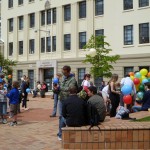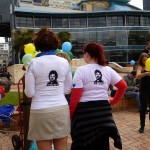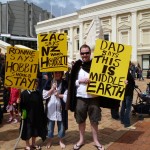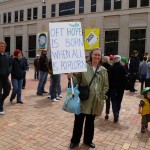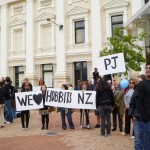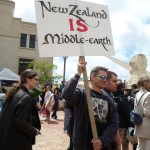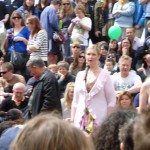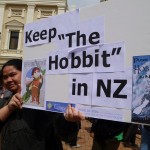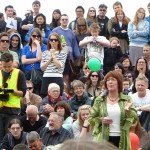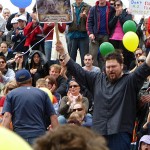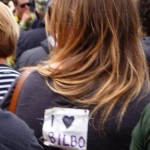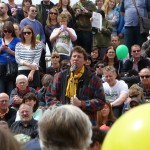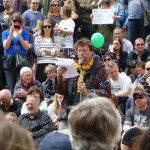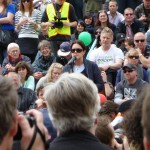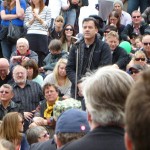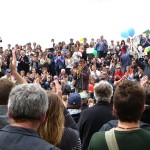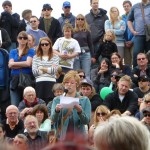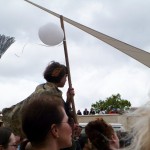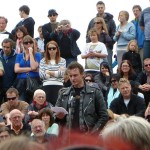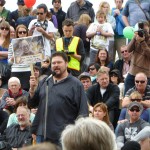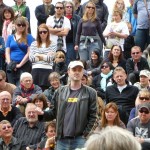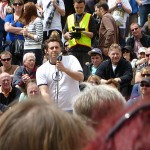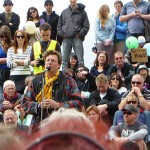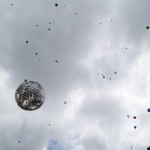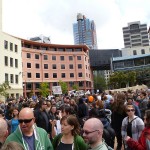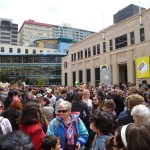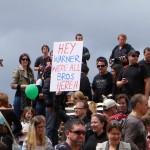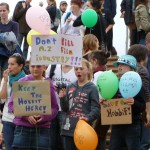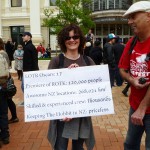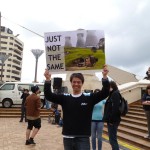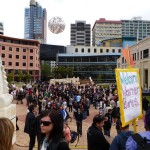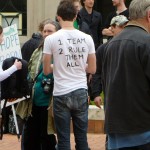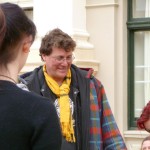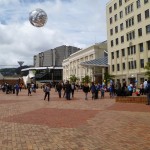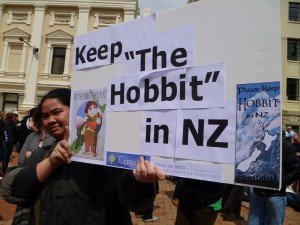 Caras Galadhon writes: Nothing short of the whole host of Mordor (and probably not even it) was going to keep me from today’s rally in Wellington’s Civic Square. After all, this was a chance to be there, see it all unfold, participate and maybe, just maybe, make a difference to the future of The Hobbit.
Caras Galadhon writes: Nothing short of the whole host of Mordor (and probably not even it) was going to keep me from today’s rally in Wellington’s Civic Square. After all, this was a chance to be there, see it all unfold, participate and maybe, just maybe, make a difference to the future of The Hobbit.
I arrived at a quarter after 12, while everyone was still slowly filtering in. Right off the bat, it was clear that this was going to be a positive event, as I saw many a smile as people drifted across the square, greeting friends, finding spots to stand or sit, and snapping pictures. It could not have been even a full ten minutes before someone offered me a balloon; the square was full of them, brightly coloured and bobbing along to the beat of music playing from the loudspeakers near the City-to-Sea Bridge.
Plenty of people had brought along signs welcoming Warner Bros. to New Zealand and affirming that the only place for Middle-earth is right here. Cast, crew and public mingled shoulder-to-shoulder, and I saw plenty of jackets, shirts and other paraphernalia identifying people’s roles in various Peter Jackson productions sprinkled liberally among the crowd. I wasn’t the only non-New Zealander there, as while I was sporting my Canada/New Zealand flag pin, I also overheard people identifying themselves as American, and more than one of the speakers we were about to hear came from further afield than the North and South Islands.
Just before 1pm, with the square full to bursting, the rally got started. After an opening song, Mayor Celia Wade-Brown began with a short speech and rallying cry asking where The Hobbit belongs, to which the crowd replied, “New Zealand!”
Next up was Richard Taylor, who gave a wonderful speech about the importance of the New Zealand arts community, and how very much The Lord of the Rings means to this country. Once he passed on Peter Jackson’s and Fran Walsh’s apologies for not being at the rally (because they are understandably quite busy just now), Richard read a really lovely letter from the two of them, thanking everyone for coming, for supporting the film industry, for being part of the making of LotR, and for being fans. There was a little dash of politics in the letter as well, primarily regarding the wisdom of allowing other countries to control the workings of New Zealand itself, but the primary message was a positive one.
From there on in there were other positive, inspiring speeches from a host of figures: Casting Director Liz Mullane, LotR Tour Guide Ted Guise, SFX Specialist Gino Acevedo, a young transplanted filmmaker from the States, crewmembers and organizers. (My apologies for forgetting a few of the names). Liz Mullane told two great stories about the challenges and joys of the Kiwi mindset: how she tried to rustle up extras for a key LotR army sequence from a number of farmers during the (extremely busy) mustering season, only to be turned down time and time again until she finally realized both what time of year it was and that LotR was being thwarted by sheep; and how suddenly in the midst of filming, the balance of their Elves were unavailable as it was finals week at Otago University, and rather than try and change the exam period like a major Hollywood production might do, they simply said, “Bugger,” and rescheduled, leading to scenes of incredibly serene, stress-free, exam-free Elves a week later.
All the speeches were focussed on the uniqueness of both New Zealand and its film industry, on how important it is to productions like The Hobbit, and how important those productions are to the country. It became obvious that this isn’t simply about one finite project which will generate jobs and then fade away, but instead it is about the continuation of a story begun when LotR filmed here. It is a story that extends far beyond short-term economics into New Zealand’s own legacy, its positioning on the world’s stage, the growth of its artistic community, of tourism and trade, and in a myriad of little ways, it is a story of family: New Zealanders, immigrants and visitors alike, their partners, their children, their friends and relatives.
Richard Taylor closed off the rally with another short speech which really illustrated what is so unique about New Zealand. He spoke of working with the Rohirrim, down on his knees strapping on their armour over and over again until he was quite tired, when he looked up to find an older woman in front of him. He didn’t quite recognize her, so he asked her if she had been on set all week. She nodded and replied she had, so he asked her if she was riding her own horse. [I’m paraphrasing a little.]
“I was,” she said, “but yesterday he stepped in a rabbit hole and came up lame.”
“Oh,” Richard blinked, “so you’ll be a footsoldier for us today?”
She smiled. “Nah, mate. Last night I went up the road, roped myself another horse, broke ‘im and trained ‘im up so he’d be all set for riding today.”
With that, there was much cheering and laughing, and the rally finished on that high note with a spontaneous release of balloons into the air.
Afterward, people filtered rather slowly out of the square, many stopping to chat with friends (and some with reporters). Richard, being the lovely person he is, stuck around for quite a long while patiently taking time for friends, fans and interviewers alike before finally wending his way out of the lingering crowd.
All in all, it turned out to be a joyous celebration of the New Zealand film community, and I certainly left feeling inspired. I hope that it inspires Warner Bros. as well, and has its intended effect, keeping The Hobbit firmly in New Zealand. I suppose we’ll see in the next few days; in the meantime, I guess we’ll all just have to hurry up and wait.


